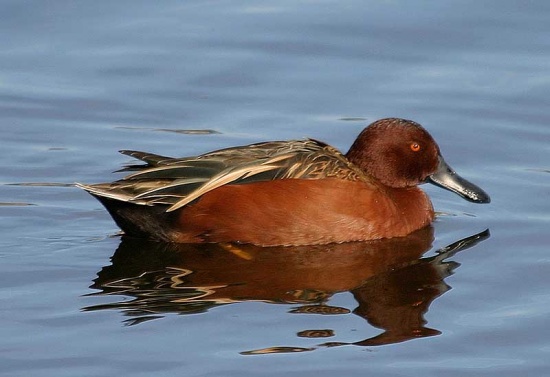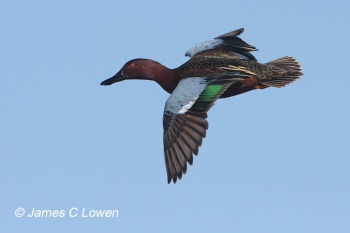m (additional photo) |
(Attempt to disguise some copied text. Flight photo added. Taxonomy expanded. References) |
||
| Line 1: | Line 1: | ||
;[[:Category:Anas|Anas]] cyanoptera | ;[[:Category:Anas|Anas]] cyanoptera | ||
| − | [[Image:Cinnamon_Teal.jpg|thumb|550px|right| | + | [[Image:Cinnamon_Teal.jpg|thumb|550px|right|Breeding adult male<br />Photo by {{user|Fulmar|Fulmar}}<br/>Upper Newport Bay, Newport Beach, Orange County, [[California]], [[USA]], February 2004]] |
| − | |||
==Identification== | ==Identification== | ||
| − | Small dabbling duck | + | Small dabbling duck<br /> |
| − | + | '''Adult Male''' | |
*Cinnamon-red head and body | *Cinnamon-red head and body | ||
*Brown back | *Brown back | ||
*Red eye | *Red eye | ||
| − | *Dark bill | + | *Dark bill<br /> |
| − | + | [[Image:Cinnamon_teal_female_type_by_macshark.jpg|thumb|350px|right|Female type bird<br/>Photo by {{user|Fulmar|Fulmar}}<br />Adobe Creek, Mountain View, [[California]]]] | |
| + | '''Adult Female''' | ||
*Mottled brown body | *Mottled brown body | ||
*Pale brown head | *Pale brown head | ||
| Line 17: | Line 17: | ||
Female very similar to female [[Blue-winged Teal]] | Female very similar to female [[Blue-winged Teal]] | ||
==Distribution== | ==Distribution== | ||
| − | Western [[North America|North]] and [[South America]]. They are migratory and most winter in [[Central America|Central]] and South America, generally not migrating as far as the Blue-winged Teal. Occurs as vagrants in the [[Caribbean]]. | + | Western [[North America|North]] and [[South America]]. They are migratory and most winter in [[Central America|Central]] and South America, generally not migrating as far as the Blue-winged Teal. |
| + | |||
| + | Occurs as vagrants in the [[Caribbean]]. | ||
==Taxonomy== | ==Taxonomy== | ||
| + | [[Image:Cinnamon Teal Lowen.jpg|thumb|350px|right|Subspecies ''cyanoptera''<br />Photo by {{user|JCL|JCL}}<br />Bahia Blanca, Buenos Aires, [[Argentina]], September 2009]] | ||
It is usually placed in genus ''Anas'', most closely allied to the [[shovelers]] and [[Blue-winged Teal]]. These species are sometimes separated into a distinct genus ''Spatula''. | It is usually placed in genus ''Anas'', most closely allied to the [[shovelers]] and [[Blue-winged Teal]]. These species are sometimes separated into a distinct genus ''Spatula''. | ||
| − | + | ====Subspecies==== | |
| − | + | There are 5 subspecies<sup>[[#References|1]]</sup>: | |
| + | *''A. c. septentrionalium'': (Northern Cinnamon Teal) | ||
| + | :*[[British Columbia]] to north-western [[Mexico]]; winters to north-western [[South America]] | ||
| + | *''A. c. tropica'': (Tropical Cinnamon Teal) | ||
| + | :*Cauca and Magdalena valleys of [[Colombia]] | ||
| + | *''A. c. borreroi'': (Borrero's Cinnamon Teal); possibly extinct | ||
| + | :*Eastern Andes of Colombia | ||
| + | *''A. c. orinomus'': Andean Cinnamon Teal | ||
| + | :*Altiplano of [[Peru]] and [[Bolivia]] to northern [[Chile]] | ||
| + | *''A. c. cyanoptera'': Argentine Cinnamon Teal | ||
| + | :*Southern Peru and southern [[Brazil]] to Tierra del Fuego and [[Falkland Islands]] | ||
==Habitat== | ==Habitat== | ||
Marshes and ponds | Marshes and ponds | ||
| Line 28: | Line 41: | ||
Generally select new mates each year. | Generally select new mates each year. | ||
====Diet==== | ====Diet==== | ||
| − | + | Dabbling ducks, the most important part of their diet is plants, but they make also eat molluscs and aquatic insects. | |
==References== | ==References== | ||
| − | # | + | #{{Ref-Clements6thDec10}}#Wikipedia |
| − | + | {{ref}} | |
==External Links== | ==External Links== | ||
{{GSearch|Anas+cyanoptera}} | {{GSearch|Anas+cyanoptera}} | ||
[[Category:Birds]][[Category:Anas]] | [[Category:Birds]][[Category:Anas]] | ||
Revision as of 23:40, 24 December 2010
- Anas cyanoptera

Photo by Fulmar
Upper Newport Bay, Newport Beach, Orange County, California, USA, February 2004
Identification
Small dabbling duck
Adult Male
- Cinnamon-red head and body
- Brown back
- Red eye
- Dark bill
Adult Female
- Mottled brown body
- Pale brown head
- Brown eyes
- Grey bill
Similar Species
Female very similar to female Blue-winged Teal
Distribution
Western North and South America. They are migratory and most winter in Central and South America, generally not migrating as far as the Blue-winged Teal.
Occurs as vagrants in the Caribbean.
Taxonomy
It is usually placed in genus Anas, most closely allied to the shovelers and Blue-winged Teal. These species are sometimes separated into a distinct genus Spatula.
Subspecies
There are 5 subspecies1:
- A. c. septentrionalium: (Northern Cinnamon Teal)
- British Columbia to north-western Mexico; winters to north-western South America
- A. c. tropica: (Tropical Cinnamon Teal)
- Cauca and Magdalena valleys of Colombia
- A. c. borreroi: (Borrero's Cinnamon Teal); possibly extinct
- Eastern Andes of Colombia
- A. c. orinomus: Andean Cinnamon Teal
- A. c. cyanoptera: Argentine Cinnamon Teal
- Southern Peru and southern Brazil to Tierra del Fuego and Falkland Islands
Habitat
Marshes and ponds
Behavior
Breeding
Generally select new mates each year.
Diet
Dabbling ducks, the most important part of their diet is plants, but they make also eat molluscs and aquatic insects.
References
- Clements, JF. 2010. The Clements Checklist of Birds of the World. 6th ed., with updates to December 2010. Ithaca: Cornell Univ. Press. ISBN 978-0801445019. Spreadsheet available at http://www.birds.cornell.edu/clementschecklist/Clements%206.5.xls/view
- Wikipedia
Recommended Citation
- BirdForum Opus contributors. (2024) Cinnamon Teal. In: BirdForum, the forum for wild birds and birding. Retrieved 6 May 2024 from https://www.birdforum.net/opus/Cinnamon_Teal





